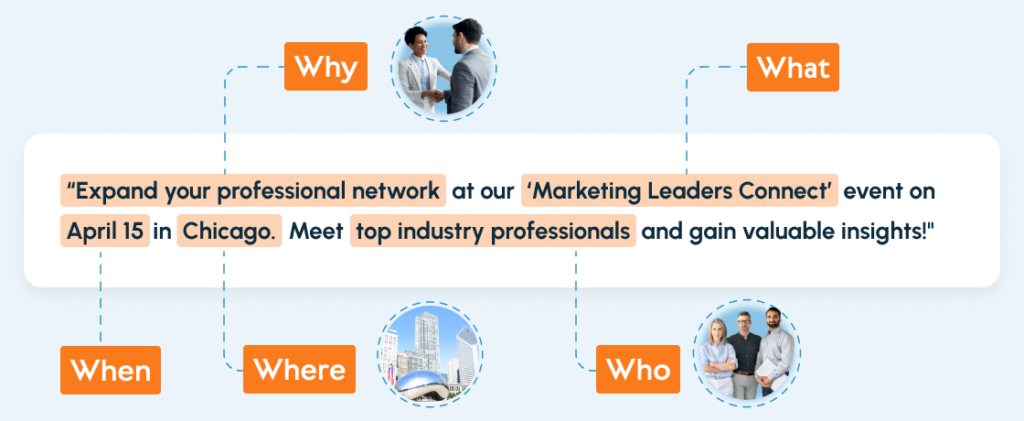You don’t need to be sold on the value of an event, be it a nonprofit fundraiser, association conference, or series of workshops. That’s not the issue; the issue is how to create buzz to get people to that event with enthusiasm (and, hopefully, money to spend). That’s where event description examples come in.
Descriptions are your first opportunity to snag your audience’s attention and begin to build interest – that, or your first opportunity to lose them, often never to retrieve those eyeballs again. If you want to forestall the latter outcome, it’s time to improve your marketing today.
What is an event description?
So just what is an event description? In a nutshell, it’s a piece of copy that tells people the basic information they need to know to decide whether or not they want to attend the event. It should always include the 5 W’s (who, what, when, where, and why) and, if necessary, an H for how.
Below, we will take a look at some event description examples that will make this concept a bit clearer. First, though, let’s take a look at exactly why descriptions are so important and how to write great copy to get people in the door.
Why are event descriptions important?
Your event descriptions are a key component in your overall event communication plan. Descriptions are often the first point of contact between you and your audience, whether they read it on your social media profile, on a website landing page, or via a Google ad served to them online.
Event descriptions, moreover, are a powerful way of reinforcing relationships with your existing members and donors, as well as reaching new ones. You should promote your blurbs to the people who already make your nonprofit or association tick as well as those who might, demographically speaking, be interested but with whom you don’t yet have a relationship.
The channels through which you market to each group will differ. For instance, your existing peeps are easy to reach through email and social media, as well as your website. Your new audience members may hang out on social media as well, but you can also find them through ads, industry partnerships, networking, and even old-school tactics such as direct mail.
Why should you focus more energy than ever before on your event descriptions? Because you can employ all the event engagement ideas in the world, but if you never get people to the front door, then you can’t expect a good return on investment. We’ll take a look at specific event description examples in a bit. First, though, let’s look at some key elements of a good description.
The key elements of a good event description

Let’s take a closer look now at the 5 W’s (and sometimes H). To wit:
Who
Who is welcome to come? All ages? All religions? Members and non-members? People below a certain income threshold? Boosters only? You want to make this information very clear, because otherwise your team will have to field a lot more questions than you would otherwise, which is a waste of resources.
Remember that in addition to the “who’s coming?” you should also answer the question “who’s hosting?” Is it your whole association? A local chapter? A partner organization? You, but with sponsors? And so forth.
What
What exactly is going on? We can divide this into two subsets: what is the event about, and what is your goal in having it? People want to know both what they can expect to do during the hours they’ll spend with you as well as what you are trying to achieve. This is related to the Why, discussed more below.
Your What should make its way into the event title (discussed more below) so that people know what you’re offering right up front. Make sure it includes both the whats: what people will do and to what cause they will contribute.
When
Pretty straightforward. When is your event? Make sure to include a year as well as a date and time. It might seem obvious to you that your event is this year, but usually there are vestiges of event collateral left on the internet after it has passed. You don’t want someone next year to ask you about last year’s doings.
Also make sure to clarify the exact days of your event. Perhaps it’s taking place Thursday-Sunday with a popup the following Monday, or what have you. Whatever the case, make it very clear in the description. For an outdoor event, always include whether it is rain or shine.
Where
Let people know where the event will take place, but make sure to include a general description of the environs. Addresses, directions, and parking instructions go below the event description, not in it. However, if your event is outdoors and you have a backup location in case of inclement weather, put that in the listing.
Why
What are we all doing here, anyway? Although the 5 W’s all contain important information about your event, this matters most, as discussed above. Without it, you haven’t given folks a reason to come, and without that reason, the rest of the information is moot.
If people are clearly going to be excited about the offering (a food festival, a workshop with someone famous), then that can be your why. However, if it’s a do-gooder cause, you must make this very clear.
How
Is there anything your guests need to know about how to get to you? This doesn’t include mere directions, which you can include below the event description. Rather, this refers to a specific but necessary step in attending the event – say, if taking a certain ferry to get to your event’s location is part of the event itself (e.g. a toast on board to kick things off).
How to write a great event description
Before we get to event description examples, it’s critical to understand the ins and outs of writing event-related copy. First, a caveat: Do not simply check your event’s main informational boxes when writing your description copy. Here is an example of what not to write:
Come celebrate Habitat for Hogmanity’s 10th birthday at Smalltown Convention Center on Saturday, May 17th, at 7 PM. Appetizers and champagne provided. All are welcome. It’s your chance to make a difference!
Now, on the surface, this seems like a pretty good description. It’s got the who, what, when, where, and why. But there are several problems:
- There’s no title.
- The why is lame. Make a difference how?
- The who is kind of confusing. Are “all” really welcome when the event is at 7 PM and champagne is on offer, or just adults? Either way, clarify so parents don’t have to dither.
- The date and time are clear enough, but then, champagne and appetizers are affordable for anyone who can afford a fundraiser, so why shouldn’t people just enjoy apps and bubbly with their friends that Saturday night? You need to make it clear why annoying things like tickets and parking would be worth it.
- And lastly, is it a fundraiser? Because the answer is probably yes unless the event is only for boosters. Either way, that needs to be reflected in the copy.
Here is a better way to write up this exact same information:
Habitat for Hogmanity Celebrates 10 Years and Fuzzy Ears
Love corkscrew tails and snorty snouts? Come celebrate the 10th birthday of Habitat for Hogmanity, the piggie rescue organization that everyone’s talking about. We’ll be down at the Smalltown Convention Center on Saturday, May 17th, at 7 PM, and we’d love to see you there. While you’re at it, you can help us raise funds for a new enclosure at our shelter farm so we can bring more hogs on board!
Enjoy a festival atmosphere with games, music, and prizes, and contribute to our cause by purchasing raffle tickets and participating in the silent auction. Champagne and appetizers are on us, with juice for your little ones. There is no cover charge, but a donation of $10 per person is suggested. The party goes till 9:30.
See the difference? The new description has a catchy title and fun, heartstring-tugging copy. Who doesn’t love pigs? Plus, it now includes every tidbit of information a person could desire, so everyone from parents to partiers can make a real plan for their evening. They also know how much they’ll be shelling out at a minimum and can decide whether to spend more from there.
To summarize, your event description should:
- Have a fun title
- Put the why upfront, so folks can immediately decide whether they care
- Spread the rest of the information throughout, forcing folks to keep reading … every second they spend on the page is another second of investment
- Include a list of all the activities and benefits they’ll enjoy (bands, speakers, raffles, etc.)
- Make it clear what you want from them (in this case, money to build a new enclosure)
- Use a tone that matches your cause; while rescue pigs call for lighthearted fun, not all missions do
So how do you source all the information you need? How do you decide on tone? How do you know who your audience is? Before we get to our event description examples, here are some tips to help.
Know your goal
What do you want from people who attend your event? As discussed above (pig enclosure), that needs to be included in the description. Otherwise people are suspicious and you don’t know what to work toward. But that means first you need to figure out what you want. Whatever your aims, make sure they:
- Are SMART: specific, measurable, achievable, relevant, and time-bound
- Match what you’re trying to do with your organization
- Reflect organizational capacity, e.g. don’t commit yourself to a 600-person event when you’re a 10-person organization
- Make sense logistically, e.g. how does the $30,000 you need for your enclosure translate to the number of cover charges, raffle tickets, and silent auction purchases you need?
Understand your audience demographic
However, you can’t just focus on your goal. Remember that your attendees have a goal too: to fix a pain point of theirs. If they stress about animal welfare, then your event will help them sleep at night. That means, in order to attract attendees, you need to know your audience. Seriously, say it with us: Know. Your. Audience.
Who actually cares about your pig enclosure? That’s your job to find out by determining your audience demographic. Demographic information includes:
- Age
- Gender
- Financial status
- Occupation
- Sexual orientation
- Ethnicity
- Preexisting membership (or not)
Smart organizations already have customer profiles or buyer personas on hand, describing their perfect members or donors, so they know to whom to market. If you haven’t yet made those, consider doing so.
Learn where they gather online
Where does your audience hang out? It’s critical to figure this out so that you can market effectively, without wasting money. You can learn this by analyzing:
- Social media and website data
- Industry statistics
- Competitors
- Interviews and surveys
- Ad platforms
Use effective selling techniques
Before we get to event description examples, one last point: you need to use effective selling techniques. That means telling people exactly what’s in it for them and you (the Why), then getting that message out to where people are. You must, therefore, have completed the above step before you begin to sell your event to the public.
FYI, an event registration app is a great way to make it easy for people to register for your event, and as such is a very effective selling technique. In the end, it doesn’t matter why someone came to your page. Whether they’re looking to contribute to your cause by attending your next fundraiser or want to learn a new skill at your latest workshop, there’s one priority that rises above those goals: simplicity. If you don’t make registration simple, your attendance will fall.
Happily, a registration app can do just that!
Examples of effective event descriptions
We made it to the good part! Let’s tackle a few specific event description examples now.
First, a brief note on pricing. While you certainly can include this in the description, and it’s often a selling point when the price is low (such as the $10 suggested cover charge for the pig-a-thon above), don’t mention pricey tickets upfront. Let people get excited about the idea before you tell them how much it costs, leaving that information for lower on the page. For that reason, you won’t see prices in most of the descriptions below.
Example 1 – Conferences and corporate events
First up on our list of important event description examples: conferences. Conferences bring people together to teach, share, support, and enable vast networking potential. Here is an example of a conference or corporate event description:
A Weekend of Myth, Magic, and Might
Put your graphic novels down and your costume on, because it’s time to head to this year’s Woodbridge Comic Con! Meet your favorite characters from television and film, buy cool gear, and show off your latest cosplay to an audience of likeminded enthusiasts.
You’ll find us at the Woodbridge Rose Center, all ages welcome (15 and younger must be accompanied by an adult). Due to popular demand, we’ve expanded our hours from last year, adding Thursday to our traditional Friday-Sunday run. Doors open at 8 AM and close at 6 PM each day, with a huge door prize and raffle ticket opportunities throughout the day.
Example 2 – Fundraisers and charities
Need to raise money for a cause? The do-gooder aspect of your event should come forward on the palate, and all the best event description examples in this category do just that. Here is an example of a philanthropic description:
An A-List Evening With Does, Joes, and Jane
Love camels, wild deer, and celebrities – as well as making a difference? Join us at our safari-themed wildlife park for an evening of petting our animal friends and hanging out with other environment enthusiasts. Other World Adventures will open its doors at 4 PM on Sunday, July 14, for fun in the sun, dinner, and a live speaker – Jane Goodall herself.
Make sure to bring your children and friends to enjoy a live band, scavenger hunt, a guided behind-the-scenes tour, and animal encounters. Tickets go to funding our new education center, where we will host classes and workshops, with additional donations welcome. Festivities go till 10 PM, rain or shine!
Example 3 – Festivals and popups
As regards event description examples for festivals and popups, fun is usually the name of the game. You want it to feel like a party before the party even begins, but make sure there’s an urgency element too. Here is an example of a festival or popup description:
The Winnipeg Keg: February’s Favorite Popup Food Festival Rides Again
Enjoy the best of Winnipeg’s food scene at our one-day popup on February 13th, held in Cozy Carl’s Grocery from 10 AM to 2 PM. Vendors from all over the city will be in attendance, so you can enjoy everything from craft beer to poutine to Valentine’s Day goodies. Tickets are $10 for adults and $5 for children under 13, which gets you entry into the event and one free drink.
Example 4 – Performances and speakers
Guest speakers and performances are big draws, but only if people know what’s on offer. If you have a celebrity, whether they’re a household name or big in your industry space, always lead with that. Here’s one of our favorite event description examples for performances:
See Blue Man Group Live While Helping Kids Thrive!
Want to enjoy the famous energy of Blue Man Group while fighting health problems among children and teens? Your ticket buys you entrance into the concert, from 5-7 PM on April 13th, as well as the beer garden and food court, only available to concert-goers. Proceeds from ticket sales will go to our signature elementary school breakfast program, Time to Shine, with additional donations welcome.
Event takes place at Azul Stadium and the adjoining outdoor brewpub, All About Ales. Restricted to those 21 and over, held rain or shine.
Example 5 – Workshops and classes
Workshops and classes are all about education, so your description must include what your attendees will learn, front and center. The pain point here is what your reader doesn’t yet know how to do, but wants to, whether that’s play an instrument, naturescape their yard, or start a nonprofit of their own. Make that your go-to. Here is an example of a workshop or class description:
Gather With Top American Writers, Agents, and Hopefuls at BWE
Learn more about the craft of writing on September 5th and 6th at the Chesapeake Bay Crusoe House, in company with a select group of authors and would-be authors. Your ticket includes all meals, an intensive workshop by universally beloved author Neil Gaiman, a nature hike, and face time with the best literary agents in the region. Doors open at 9 AM Saturday and close 9 PM Sunday, so you won’t waste a minute!
Example 6 – Virtual Events
Last on our list of event description examples: virtual events. These have been gaining momentum for decades, but COVID-19 really pushed virtual events into the everyday space. The main thing to watch out for here is the disconnect introduced when everyone is behind a screen. Therefore, your description needs to create a powerful community feel. Here is an example of a virtual event description:
Learn to Feed a Crowd With Giada de Laurentiis … Right From Your Living Room!
You’re already used to getting cooking tips from Giada de Laurentiis right from home, so why fix what ain’t broken? Tune in to our livestream event on Friday, December 12 at 3 PM, when the celebrity chef will share tips on cooking holiday meals that convert. Featured dishes include rack of lamb, rosemary mashed potatoes, and balsamic carrots … with a surprise dessert!
Make sure to bring your notebook and a good pen. All proceeds from ticket sales go to Meals on Wheels.
Never sweat event descriptions again: Final tips
Event descriptions might sound difficult, but once you understand what you’re doing, they become much less intimidating. Here are some final tips to help make the process easier:
- Write out all of your information ahead of time so you have it in one place.
- Plan where you will use your description, so you can take any limitations or alterations into account (for example, there are no titles in Instagram captions, so you will want an alternate version).
- Ask the best writer at your organization to handle the descriptions. Don’t have one who cuts the mustard? Reach out to a donor, board member, or writing service.
- Use membership software to help you keep track of events, attendees, signups, donations, and everything else you need to keep your organization running!
This last point is especially important. There’s no point reading all these event description examples if you’re not going to ensure the best possible turnout and execution, right? Luckily, MemberClicks is here to help, with industry-leading software that will help you keep all the info you need in one place.
Ready to learn how our tools can help you pull off the best possible fundraiser, retreat, conference, popup, workshop, hoedown, or anything else? Don’t hesitate to contact us for a free demo today!
















